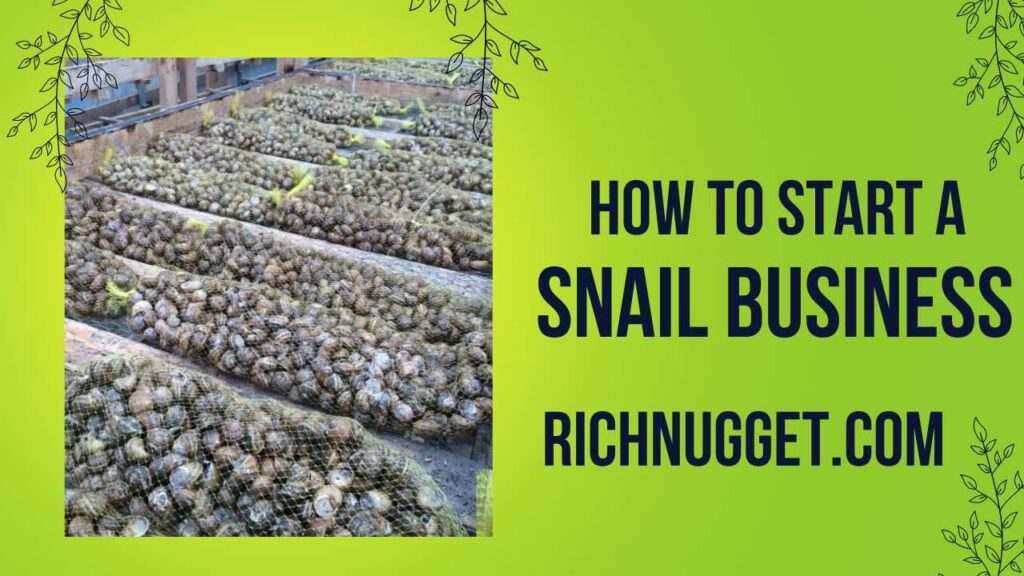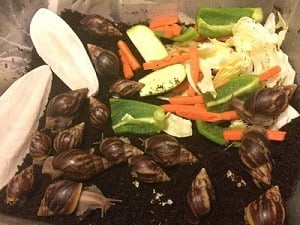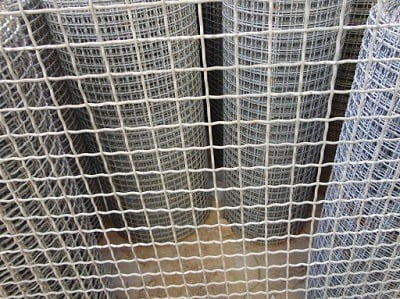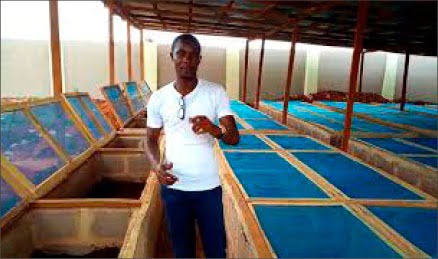
The snail farming business in Nigeria is a very profitable business that can yield millions if you are serious about it.
This business is not only profitable but also costly to run.
And one way to manage a business so effectively is by continuous absorption of knowledge.
And part of the knowledge needed to run a successful personal or commercial snail farming business is what I will be revealing in this article.
There are several steps that must be taken before you can start benefiting from this snail business.
Table of Contents
Steps to Starting a Snail Farming Business in Nigeria
1. Market Demand
No matter what you produce, no matter how big/healthy it is, no matter how plenty they are. The market demand is what determines your success.
The first thing to put into consideration before starting the snail farming business is to check the market demand for snails in the city/state where you want to run your snailery business.
The price of snails in Nigeria is as high as 5,000 Naira per kg depending on their sizes and location.
But in other to know the market demand in that city/state you must familiarise yourself with the market women in that city to know their selling and buying cost of snails, meet other snail farmers in the same city, and ask if they have a union that controls the price.
With this information, you can easily penetrate the market without much stress and with a higher profit of course.
But if the market demand for snails is low; mostly in the northern part of Nigeria (because the northerners don’t eat snails), there is no need to embark on the journey of starting a snail farm in that city, except if you intend exporting it out of the city.
2. Snail Pens
Snails are creatures that like a very cold environment. This is something that by observation you should have noticed.
You must have noticed that the only place you can see snails are where there are shades from trees or dark spots.
So when you are constructing your pen; you must make sure that the pen has the feature of coldness and shades as you can see below

A bit of a wet environment is still to be considered because snails don’t like dry places.
When is dry season, it becomes difficult for snails to adapt.
The best solution is to always wet the pens and environment at least two to three times a day to keep it natural
The last thing to consider is to include plants in the pen that snails either eat from or use as a form of extra shade 0r both.
3. Where to buy snails for farming in Nigeria
The productivity of your snail depends also on where you bought the snail from.
When sourcing your snails, one mistake you can make is to buy your snails from market women.
The reason why it is not advisable to buy your snails from market women is; “you don’t know the current state of the snails because of their enduring nature and how long they have been with the sellers”.
The best places to get your snails are either from the bush or from snail breeders who are selling them.
4. Species Selection and Stock Acquisition:
Before starting a snail farming business in Nigeria, it is recommended to select a snail species that not only have the dogdeness to survive the terrine but also has the market demand.
In Nigeria here are the snail species used for snail farming by snail farmers:
Achatina achatina (Giant African Land Snail): Achatina achatina is one of the largest snail species and is widely farmed for its size and meat quality. It is native to West Africa, making it well-suited to the climate in Nigeria. This species is known for its voracious appetite and rapid growth under favorable conditions.
Achatina marginata (Giant West African Snail): Achatina marginata is another popular species in snail farming, appreciated for its adaptability and reproductive capabilities. It is native to West Africa, including Nigeria, and is commonly found in various ecological zones.
Achatina fulica (East African Land Snail): Achatina fulica, also known as the East African Land Snail, has been introduced to various regions, including Nigeria, for farming purposes. It is recognized for its widespread distribution and has adapted well to different environments.
Archachatina marginata (Giant African Forest Snail): Archachatina marginata is a forest-dwelling snail species found in Nigeria and other parts of West Africa. It is appreciated for its size and is often farmed for both subsistence and commercial purposes.
Limicolaria species: Some farmers also engage in the farming of Limicolaria species, which are smaller in size compared to Achatina species. These snails are known for their adaptability and are found in various regions of Nigeria.
It’s important for you to choose species that aligns with your farming goals and the preferences of your target market
After selecting the suitable snail species you will be using for your snail farming business, the next step is to acquire the initial breeding stock for your snail farm. Here’s how to go about it:
- Purchase Healthy and Mature Snails: Source healthy and mature snails for breeding purposes. Mature snails are essential for initiating the breeding process and ensuring reproductive success.
- Verify Health Status: Inspect the snails for signs of good health, such as a well-formed and intact shell, active movement, and responsive behavior. Check for any abnormalities or signs of disease. It is crucial to start with disease-free stock to prevent the spread of illnesses within the snail population.
- Disease and Parasite-Free: Ensure that the acquired snails are free from common snail diseases and parasites. Infected snails can introduce diseases to the entire farm, leading to significant losses.
- Quarantine Procedures: Implement a short quarantine period for newly acquired snails. This allows for observation and further verification of their health status before introducing them to the main breeding stock.
- Genetic Diversity: Consider introducing genetic diversity into your breeding stock to enhance the overall resilience and adaptability of the snail population.
Acquiring a healthy and disease-free breeding stock is foundational to the success of your snail farming business.
5. Feeding and Nutrition:

It is less expensive to feed snails, as you can use foreign feed, local feed, or both.
The nutritional requirements for snails vary throughout their growth cycle, and providing the right feed at each stage is crucial for optimal growth and development.
Feed for a snail growth cycle:
Hatchlings (1-2 weeks):
- Offer finely crushed or powdered feed suitable for the small size of hatchlings.
- Use feeds with high protein content to support the rapid growth phase.
- Ensure that the feed is easily consumable for the tiny snails.
Juveniles (2 weeks to 5-6 months):
- Provide a mix of protein-rich feeds and those with a balanced nutrient profile.
- Introduce fresh green vegetables and leafy plants to the diet.
- Calcium supplements are essential for shell development during this stage.
Sub-Adults (5-6 months to 1 year):
- Continue with a balanced diet that includes protein, carbohydrates, vitamins, and minerals.
- Increase the amount of calcium-rich foods to support the continued growth of the shell.
- Introduce a variety of fruits and vegetables for nutritional diversity.
Adults (1 year and older):
- Maintain a balanced diet with a focus on calcium-rich foods to ensure shell strength.
- Gradually reduce the protein content in the diet as snails reach maturity.
- Continue offering a variety of vegetables and fruits for overall nutrition.
Reproductive Stage (during mating and egg-laying):
- Supplement the diet with foods rich in nutrients needed for reproduction.
- Ensure an adequate supply of calcium, as this is crucial for the development of eggs and shells.
General Feed Considerations for snail farming:
- Provide clean and fresh water at all times, especially during dry periods.
- Avoid overfeeding to prevent food spoilage and maintain a clean environment.
- Monitor the snails’ behavior and adjust the diet accordingly.
- Consider using commercial snail feeds, which are formulated to meet the nutritional needs of snails at different stages.
Another thing to consider when it comes to snail feeding is the nutritional tips. Here are some feeding and nutrition tips for snails in Nigeria:
- Calcium-Rich Diet: Provide a diet rich in calcium, as it is crucial for the development and maintenance of snail shells. Offer sources of calcium such as limestone, eggshells, or commercial snail feed supplements.
- Balanced Diet: Ensure a balanced diet that includes a mix of protein, carbohydrates, vitamins, and minerals. Supplement the diet with fruits and vegetables to provide essential nutrients.
- Leafy Greens: Offer a variety of leafy greens like cabbage, lettuce, and spinach, which are good sources of nutrients for snails. Ensure that the greens are fresh and free from pesticides.
- Fruits and Vegetables: Provide fruits like pawpaw, banana, and cucumber in moderation as a source of additional vitamins and moisture. Include vegetables such as carrots and bell peppers for added nutritional diversity.
- Avoid Salty Foods: Avoid feeding snails salty or spicy foods, as these can be harmful to their health. Snails are sensitive to high levels of salt, which can negatively impact their well-being.
- Feed in the Evening: Feed snails in the evening or during cooler hours to mimic their natural feeding habits. This helps prevent stress and ensures that they are more active during feeding.
- Clean and Fresh Water: Provide clean and fresh water at all times to keep snails hydrated. Use shallow containers to prevent drowning, and regularly clean and refill water sources.
- Avoid Overfeeding: Avoid overfeeding to prevent food spoilage and the growth of harmful microorganisms. Remove uneaten food to maintain a clean environment.
- Commercial Snail Feed: Consider supplementing the diet with commercial snail feed, which is specially formulated to meet the nutritional needs of snails. Follow recommended feeding guidelines for commercial feeds.
- Monitor Feeding Behavior: Observe the snails’ feeding behavior and adjust the diet accordingly. If there are signs of reluctance to eat or changes in behavior, investigate potential health issues.
- Seasonal Adjustments: Adjust the diet based on seasonal changes, considering factors like temperature and humidity that may affect snail feeding patterns.
By following these feeding and nutrition tips, you can ensure that your snails receive the essential nutrients they need for optimal growth and health.
6. Disease and pest control In Snail Farming
As much as snails are animals that have a strong resistance to diseases, it is also mandatory not to bank on such risk.
Snail rearing like I said before is very profitable and lucrative but you can lose in this business if you don’t tackle parasites and predators that affect the snails.
Below are the predators and parasites to watch out for in the snail farming business
Snails predators:
1. Reptiles
Reptiles such as; frogs, rats, centipedes, millipedes, etc can cost you all your investment.
The frogs tend to eat the small snails and the eggs, while snakes, rats, and other reptiles eat both young and old snails.
So when you are building your snail pens you must put these predators in mind so you won’t be caught unaware.
You can prevent these predators’ attacks by covering your snail pens with wire mesh and mosquito net.


2. Ants
Soldier ants are another serious problem for snails.
You conquer these predators by building a gutter around your pens (if it is a low trench pen: a “concrete pen”. Like the one above).
But if it is a wooding pen you put each leg of the pen in an empty can full of water or oil. So when the ants try to make an attempt of climbing, they can easily fall into the water or oil.
And for the guilter around your low trench pens, you will either put oil or water in the gutter.
Snail Parasites:
1. Flies and their eggs
Flies of any kind. What these flies do is; lay eggs.
The eggs stage is not harmful to the snails until they move into the larva stage which becomes very dangerous to the snails because they feed on the snails.
This is why you cover your pens with a mosquito net to avoid every such insect; “flying or crawling”.
Also, make sure you clear leftover foods from the pens as their decay can affect them.
And always keep your pens neat.
Disease to snails
The main disease of snails is fungi and this disease leads to mortality.
And it is contracted by contact with another snail already affected or contracted through linking each other slime.
The fastest remedy to curbing the spread is through quarantining the infected.
There are other things to be knowledgeable of, but you can access them through a one on one training or by employing an expert who has at least 2 years of experience to work alongside you.
The reason for employing the expert is to help you prevent costly mistakes as you go with your day-to-day activities in rearing your snails.
But with the knowledge so far that I have given you via this article, you can start a small snail farm in your backyard as a beginner, and in a matter of time, you will become the biggest commercial snail farm owner.
Sell your Snails
In Nigeria, there are various avenues where you can sell your snails. Here are some potential places to consider:
- Local Markets:
- Supermarkets and Grocery Stores
- Restaurants and Hotels
- Online Platforms
- Export Companies
- Butchers and Meat Shops
- Community Supported Agriculture (CSA) Programs:
- Educational Institutions that may have Culinary Programs or Canteens
Building relationships with buyers and consistently delivering quality products will contribute to the success of your snail farming business in Nigeria.
How much does it cost to start a snail farming business in Nigeria?
According to the current market price in Nigeria, the cost of starting a snail farm in Nigeria is dependent on the scale on which you decide to run your snail farm.
But for easy understanding, I will be using a small-scale cost for my calculation.
So let’s assume you decide to start with a bucket as your snail pen or a basket pen.
The cost of lay-ready snails for rearing is ₦750. Let’s say you decide to buy 100 which will be a total of ₦75,o00 — You can start with below 100 snails as your choice.
The cost of feed for these 100 snails shouldn’t be more than 2 bags of snail feed per 3 months but if you also mix the snail feeding with local feeds (which are mostly free) the 2 bags of snail feed will last up to 4 months.
The two bags of foreign snail feed cost ₦10,000 each; that gives us a total of ₦20,000.
The cost of a basket is ₦500 per one. You purchase 4basket which gives us a total of ₦2,000
The total cost of starting a snail farm in Nigeria; 75,000 + 20,000+ 2,000 = ₦97,000
Approximately with ₦100,000 this business should be up and running.
With this calculation, you can easily get the cost of running a large-scale snail farming in Nigeria just by increasing the cost of each item prementioned.
How much can you make from snail farming in Nigeria?
When you are done with setting up your snail farm and is time to start selling the mature ones, to make a good return you must not sell your snails single, or else you will make little to no profit.
To make a good profit/return in the Snail business, you only sell per kilogram (Kg). It takes about 9 fresh snails to make a Kg. —A Kg cost ₦5,000
But a processed frozen snail Kg costs ₦15,000.
Let’s say you selling at ₦5,000 per Kg (which is made up of 9 Jimbo fresh snails).
And remember we started the snail farm with 100 snails. A snail lay up 200 to 500 eggs per annum.
Using the minimum of 200 lay eggs per snail becomes 100snails X 200 = 20,000 snails per year
20,000 snails divided by 9 = 2,222Kg
2,222kg X ₦5,000 =₦11,110,000
₦11,110,000 per annum is how much you can make from snail farming in Nigeria.
With the above calculations of the cost and profit of starting a snail-farming business in Nigeria, it obviously clear that the snail business is very lucrative.
Target Market For Snail Farming Business In Nigeria
Here are potential target markets for snail farming business in Nigeria:
- Local Consumers: Individuals and households seeking a local and sustainable source of protein. This market segment includes those who appreciate the nutritional value and unique taste of snails.
- Restaurants and Hotels: The hospitality industry, including restaurants, hotels, and catering services, represents a significant market for snail farmers. Chefs may include snail dishes on their menus to cater to customers looking for unique and exotic culinary experiences.
- Grocery Stores and Supermarkets: Retail outlets, grocery stores, and supermarkets are potential outlets for selling processed or packaged snail products. This market segment caters to consumers looking for convenient and readily available snail products.
- Specialty Food Markets: Specialty food markets that focus on organic or exotic products may be interested in offering snail products to their customers. This includes farmers’ markets and specialty food stores.
- Export Markets: For larger-scale snail farming operations, exploring international export markets should be a strategic option. Meeting quality standards and complying with export regulations are crucial for accessing and maintaining a presence in such markets.
- Educational and Training Institutions: Educational institutions and training centers may be interested in incorporating snail farming into their agricultural or culinary programs. Snail farming workshops and training sessions can target aspiring farmers and entrepreneurs.
- Health and Wellness Market: Snail products are often promoted for their nutritional benefits. The health and wellness market, including fitness enthusiasts and those seeking alternative protein sources, can be targeted through marketing campaigns emphasizing the health benefits of snail consumption.
- Cosmetics and Pharmaceutical Industries: Snail slime (mucus) is valued for its potential cosmetic and medicinal properties. The cosmetics and pharmaceutical industries may be interested in sourcing snail slime for skincare and pharmaceutical products.
- Online Platforms: Leveraging online platforms for marketing and sales can expand the reach of snail farmers. Selling directly to consumers through e-commerce platforms or social media can be an effective strategy.
- Community Events and Festivals: Participating in community events, fairs, and festivals provides an opportunity to showcase and sell snail products directly to local consumers. This can also help in building brand awareness.
- Cultural and Religious Markets: Tailoring marketing strategies to appeal to cultural or religious preferences can be effective. Understanding local customs and preferences is crucial in certain regions.
- Processed Snail Products: Developing and marketing processed snail products, such as canned snails, snail powder, or snail-based snacks, can open up new market opportunities.
Best Practices for Successful Snail Farming in Nigeria
Here are some best practices for successful snail farming in Nigeria:
- Site Selection: Choose a location with suitable soil and climate conditions for snail farming. Ensure good drainage to prevent waterlogging, as snails are sensitive to damp environments.
- Species Selection: Select the right snail species for farming, considering factors like growth rate and adaptability to the Nigerian climate.
- Housing and Infrastructure: Construct well-ventilated pens or cages to provide a conducive environment for snails. Ensure the housing protects snails from predators and extreme weather conditions.
- Feeding and Nutrition: Provide a balanced diet rich in calcium for shell development. Supplement with fruits, vegetables, and feed to meet their nutritional needs.
- Hydration: Ensure a constant and clean water supply for the snails, as dehydration can be detrimental to their health.
- Breeding Management: Separate snails by size and age to prevent cannibalism and ensure optimal growth. Create a controlled environment for mating and egg-laying.
- Pest and Disease Control: Implement preventive measures to control pests and diseases. Regularly inspect snails for signs of illness and isolate affected individuals promptly.
- Record Keeping: Maintain detailed records of the snail farm, including breeding, feeding, and health observations. Use records to track performance and identify areas for improvement.
- Harvesting Techniques: Harvest snails at the right size and age for maximum profitability. Use humane methods to minimize stress during harvesting.
- Marketing and Sales: Develop effective marketing strategies to promote your snail products. Establish connections with local markets, restaurants, and potential buyers.
- Compliance with Regulations: Familiarize yourself with and adhere to relevant regulations and licensing requirements for snail farming in Nigeria.
- Continuous Learning: Stay updated on the latest snail farming techniques and best practices through research and networking.
By incorporating these best practices, you can enhance the chances of success in your snail farming venture in Nigeria.
Snail Farming Equipment and Infrastructure
Here are essential equipment and infrastructure needed for snail farming:
1. Housing:
- Snail Pens or Cages: Construct well-ventilated pens or cages to house snails. Ensure they are secure to protect against predators and provide a conducive environment.
- Fencing: Install fencing around the snail farm to prevent unauthorized access and protect snails from predators.
2. Soil and Substrate: Snails require specific soil types for laying eggs and maintaining shell health. Ensure the soil is free from harmful chemicals and has good drainage.
3. Feeding and Watering Equipment:
- Feeding Troughs: Provide feeding troughs or designated areas for feeding to prevent food wastage and contamination.
- Watering Systems: Set up a system to provide clean and fresh water to the snails, ensuring they stay hydrated.
3. Climate Control:
- Shade Structures: Protect snails from extreme weather conditions by providing shade structures, especially during hot periods.
- Misting Systems: In areas with low humidity, consider misting systems to maintain a suitable environment for snails.
4. Breeding Management Equipment:
- Separation Units: Use separate pens or units for mating and egg-laying to control breeding.
- Egg Collection Containers: Provide containers filled with suitable substrate for snails to lay eggs.
5. Hygiene and Waste Management:
- Cleaning Tools: Regularly clean pens, removing debris and waste to maintain a clean environment.
- Composting Area: Establish a designated area for composting snail waste, which can be used as fertilizer.
6. Record-Keeping Tools: Keep detailed records of the snail farm using notebooks or software, including breeding, feeding, and health observations.
7. Harvesting Tools:
- Harvesting Containers: Use containers or baskets for collecting snails during harvesting.
- Humane Harvesting Tools: Employ humane methods to minimize stress during harvesting.
8. Security Measures: Install security cameras (not an option for large scale snail farmers) to monitor the farm and deter theft or unauthorized access. In addition, Implement access control measures to restrict entry to authorized personnel.
9. Training and Handling Tools:
- Educational Materials: Provide materials for training farm workers on proper snail handling and care.
- Gloves and Aprons: Equip workers with protective gear when handling snails.
10. Transportation Containers: Such as ventilated boxes or crates are used for transporting snails to markets or buyers.
Nigerian Climate and Its Impact on Snail Farming
The Nigerian climate plays a significant role in the success of snail farming, as snails are highly sensitive to environmental conditions.
Here’s an overview of the Nigerian climate and its implications for snail farming:
Temperature:
- Impact: Snails thrive in moderate temperatures. High temperatures can lead to dehydration, while extremely low temperatures can slow down their metabolism.
- Management: Provide shade structures to protect snails from direct sunlight during hot periods. In colder regions, consider additional insulation or heating mechanisms.
Humidity:
- Impact: Snails require a humid environment for proper growth and to prevent desiccation (drying out). Low humidity can lead to stress and reduced activity.
- Management: Use misting systems or other methods to maintain humidity levels, especially during dry seasons.
Rainfall:
- Impact: Snails are sensitive to waterlogged conditions, which can lead to respiratory issues. However, they need moisture for hydration and to keep their surroundings humid.
- Management: Ensure proper drainage in snail pens to prevent waterlogging. During the dry season, provide adequate water sources and consider supplemental irrigation.
Seasonal Changes:
- Impact: Snail activity and reproduction may vary with seasonal changes. In the dry season, snails may aestivate (become dormant) to conserve moisture.
- Management: Adjust feeding and management practices based on seasonal variations. Provide additional moisture during the dry season.
Wind and Storms:
- Impact: Strong winds and storms can damage snail housing and stress the snails.
- Management: Secure pens and cages to withstand wind and storms. Provide sheltered areas to protect snails during adverse weather conditions.
Soil Quality:
- Impact: The type of soil in a region affects snail health and reproduction. Soil with good drainage is essential to prevent waterlogging.
- Management: Conduct soil tests to ensure it is suitable for snail farming. Amend the soil as needed for proper drainage.
Pest and Disease Incidence:
- Impact: Climate influences the prevalence of pests and diseases that can affect snails.
- Management: Regularly monitor snails for signs of pests and diseases. Implement preventive measures to control their spread.
Forage Availability:
- Impact: Climate affects the availability of natural forage, such as green vegetation, which is an essential part of the snail diet.
- Management: Supplement the snail diet with suitable feeds during periods of forage scarcity.
Understanding and adapting to the Nigerian climate is essential for maintaining optimal conditions for snail growth and reproduction.
Challenges of Snail Farming Business in Nigeria
Here are the challenges and potential solutions in the snail farming business in Nigeria:
- Climate and Habitat Requirements: Snails are sensitive to environmental conditions, and maintaining the right habitat can be challenging.
Solution: Create controlled environments with suitable temperature and humidity. Employ shade nets and proper shelter to protect snails from harsh weather conditions. - Predators and Pests: Snails are susceptible to predators such as birds, rodents, and insects, as well as pests that can harm snail eggs and hatchlings.
Solution: Implement protective measures such as wire mesh fences, pest control methods, and the use of organic deterrents to safeguard snails. - Slow Growth and Reproduction Rate: Snails have a slow growth rate, and reproduction can be relatively slow.
Solution: Implement selective breeding practices to enhance growth rates. Ensure optimal conditions for reproduction, including maintaining a balanced male-to-female ratio. - Disease Management: Snails can be susceptible to diseases, and infections can spread quickly in crowded or unhygienic conditions.
Solution: Practice good hygiene by regularly cleaning and disinfecting the snailery. Provide a well-ventilated environment and quarantine infected snails to prevent the spread of diseases. - Market Acceptance and Awareness: Limited market awareness and acceptance of snail products in some regions.
Solution: Engage in marketing and awareness campaigns to educate consumers about the nutritional benefits of snail meat. Explore partnerships with restaurants and markets to increase demand. - Capital Intensity: Establishing a snail farm can be capital-intensive, requiring investment in infrastructure, breeding stock, and suitable habitat.
Solution: Seek funding through agricultural loans, grants, or partnerships. Start on a smaller scale and gradually expand as the business grows. - Regulatory Compliance: Navigating regulatory requirements for snail farming can be complex.
Solution: Stay informed about relevant regulations, obtain necessary permits, and engage with agricultural authorities for guidance. Joining industry associations can provide additional support. - Limited Technical Know-How: Limited technical knowledge and skills among farmers.
Solution: Attend training programs, workshops, and seminars on snail farming. Collaborate with agricultural extension services, research institutions, and experienced snail farmers for guidance. - Marketing and Distribution: Developing effective marketing channels and distribution networks can be challenging.
Solution: Establish partnerships with supermarkets, restaurants, and local markets. Leverage online platforms and social media for marketing and sales. - Seasonal Variations: Snail activity and growth may vary with seasonal changes.
Solution: Implement seasonal management practices, such as providing additional shelter during extreme weather conditions. Plan breeding cycles to align with favorable seasons.
Recommended Article
- Poultry farming business in Nigeria
- Fish farming business In Nigeria
- How to Start a Successful Goat Farming Business in Nigeria
- Start a Pig Farming Business in Nigeria: Make 500k to a million monthly
- 10 Money-Making Agriculture Business Ideas
Conclusion
Starting a successful snail farming business in Nigeria involves a combination of practical knowledge, commitment, and adaptability.
By following these steps and continuously improving your practices, you can build a sustainable and profitable snail farming venture.
Hope you benefited from this article: “How to Run a Lucrative Snail farming Business in Nigeria”
If you have a question or contribution, please leave them in the comment section below.
Be a Lifter via the Share Buttons to others who wants to start a lucrative business.
Remember to use the Subscribe Buttons (email or bell-shaped) for new Updates
Discover more from StartBizEasy
Subscribe to get the latest posts to your email.





